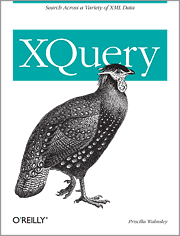fn:normalize-unicode
Normalizes according to a Unicode normalization form
Description
The fn:normalize-unicode function performs Unicode normalization, which allows text to be compared without regard to subtle variations in character representation. It replaces certain characters with equivalent representations. Two normalized values can then be compared to determine whether they are the same. Unicode normalization is also useful for allowing character strings to be sorted appropriately.
The $normalizationForm argument controls which normalization form is used, and hence which characters are replaced.
All implementations support the value NFC for $normalizationForm; some implementations may support other values.
This description is © Copyright 2007, Priscilla Walmsley. It is excerpted from the book XQuery by Priscilla Walmsley, O'Reilly, 2007. For a complete explanation of this function, please refer to Appendix A of the book.
Arguments and Return Type
| Name | Type | Description |
|---|---|---|
$arg |
xs:string? |
the string to normalize |
$normalizationForm |
xs:string |
the normalization form |
| return value | xs:string |
Examples
| XQuery Example | Results | Explanation |
|---|---|---|
normalize-unicode('query') |
query |
|
normalize-unicode('query', '') |
query |
|
normalize-unicode('£', 'NFKC') |
£ |
Converts £ to £. |
normalize-unicode('leçon', 'NFKD') |
lecon |
Converts leçon to leçon. There are two characters in the output, a "c" and a separate cedilla, but they are probably not visible separately in your browser. |
normalize-unicode('15 ㎗') |
15 ㎗ |
|
normalize-unicode('15 ㎗', 'NFKC') |
15 dl |
Converts ㎗ to the letters 'dl'. |
History
| Published On | Last Updated | Contributor(s) |
|---|---|---|
| 2006-06-27 | 2007-02-26 | W3C, XQuery 1.0 and XPath 2.0 Functions and Operators, http://www.w3.org/TR/xpath-functions/ |

